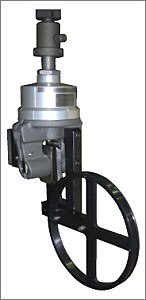Optical Fiber Tensile Jig

Features:
- Specifically for tensile testing optical fibers and other brittle fibers
- Pneumatic action minimizes specimen slippage at the grip faces
- 0.1 kN (22 lbf) maximum capacity
Relevant Materials:
Glass
Relevant Specimens:
Fibers
This jig is designed for tensile testing optical fibers and other brittle fibers. The jig consists of upper and lower pneumatic flat grips with flat grip faces followed by large-diameter capstans.
The pneumatic flat grips apply a constant pressure during testing, minimizing slippage of the specimen at the grip faces, and the large-diameter capstan reduces stress on the fiber, lowering the risk of specimen breakage at the chuck. In addition, the capstan itself applies a self-tightening action and the two capstans are arranged on opposite sides of the testing axis to minimize off-axis forces.
A maximum operable air pressure of 0.7 MPa (7 kgf/cm2, 102 psi) is available for the pneumatic flat grips. A foot valve unit is necessary to open and close the pneumatic flat grips. An air compressor is not included in the optical fiber tensile jig set. In certain regions, an air compressor is available as an accessory. Please contact your local Shimadzu representative for availability.
Additional items needed for operation:
- A 0.7 MPa (7 kgf/cm2, 102 psi) air compressor
- Foot valve unit
News / Events
-
AUTOGRAGH AGS-X2 Series has been released
The Shimadzu AUTOGRAPH AGS-X2 series provides superior performance and practical testing solutions for a wide array of applications. Offering high-level control and intuitive operation, the AGS-X2 series sets a new standard for strength evaluations while providing the utmost in safety considerations in a modern, stylish design.
-
AUTOGRAGH AGS-V Series has been released
Shimadzu Corporation released the Autograph AGS-V Series precision universal testing machine. In this series, the range over which the force measurement accuracy is guaranteed has been increased by a factor of two compared with existing machines. As a result of this new function, the work required to change force measurement sensors and accessories required for measurement can be reduced.
-
High-Speed Video Camera HyperVision HPV-X3 has been released
Recording speed of 20 million frames/second, the highest in its class provides larger, clearer, high-sensitivity recording. HPV-X3 is equipped with a synchronized recording function and high-level analytical capabilities that accommodate a variety of software programs.
-
New Video: AUTOGRAPH AGX-V2 Voice Operation Device XV-Talk
We will introduce how XV-Talk, the world's first voice control device installed in Shimadzu's latest tensile tester AGX-V2, can be used in various scenarios.
-
New Video: AUTOGRAPH AGX-V2 Operation Control Panel Stand-alone test feature
We will introduce a new feature of Shimadzu's latest tensile tester, AGX-V2, a stand-alone testing function using a large color LCD touch panel.
-
New Autograph AGX-V2 Series Precision Universal Testing Machines
The World’s First Testing Machines Equipped with a Voice Operation Device


